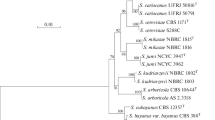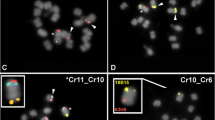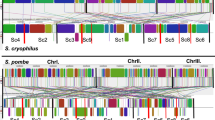Abstract
By a genomic comparison of two sibling yeasts, Saccharomyces bayanus and S. cerevisiae, we previously demonstrated that chromosomes II and IV of S. cerevisiae were rearranged into chromosomes 12 and 14 of S. bayanus or vice versa. In the present study we have delimited the translocation break sites in chromosomes II and IV by Southern hybridization using DNA fragments of S. cerevisiae cosmid clones as probes. The results suggest that the reciprocal translocation of chromosomes II and IV had occurred at duplicated RPL2 loci. Furthermore, the translocation sites in S. bayanus were confirmed by the cloning and sequence analysis of the regions flanking RPL2 loci. Several genes in the regions flanking the RPL2 loci were present in the order expected for a translocation at these loci between the two species. These results indicated that the reciprocal translocation between chromosomes II and IV was generated by homologous recombination at duplicated RPL2 loci on the two chromosomes. Therefore, we propose that duplicated genes or duplicated regions play an important role in altering genomic organization during the speciation of S. bayanus and S. cerevisiae.
Similar content being viewed by others
Author information
Authors and Affiliations
Additional information
Received: 20 October 1997 / 2 March 1998
Rights and permissions
About this article
Cite this article
Ryu, SL., Murooka, Y. & Kaneko, Y. Reciprocal translocation at duplicated RPL2 loci might cause speciation of Saccharomyces bayanus and Saccharomyces cerevisiae. Curr Genet 33, 345–351 (1998). https://doi.org/10.1007/s002940050346
Issue Date:
DOI: https://doi.org/10.1007/s002940050346




